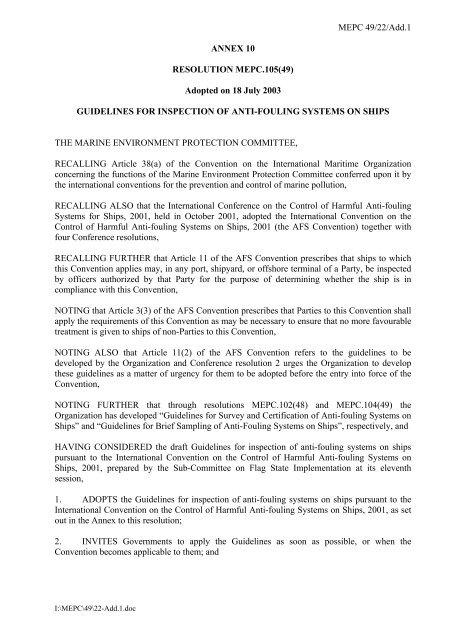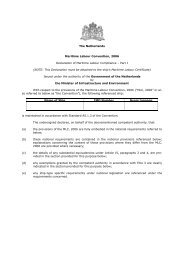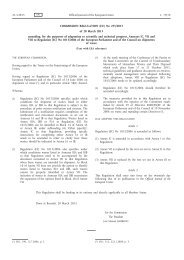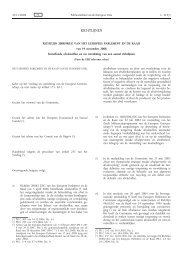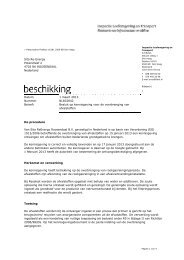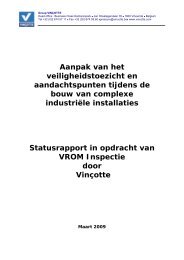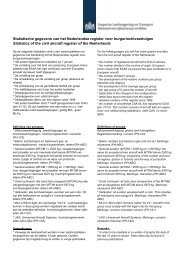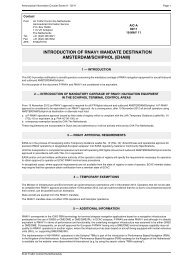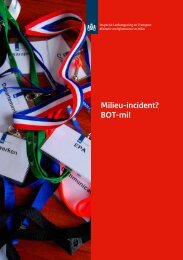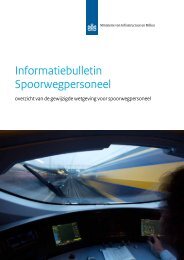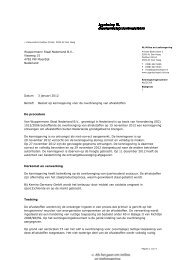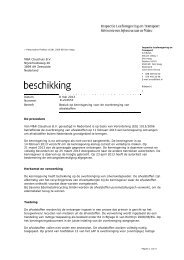MEPC 49/22/Add.1 ANNEX 10 RESOLUTION MEPC.105(49 ...
MEPC 49/22/Add.1 ANNEX 10 RESOLUTION MEPC.105(49 ...
MEPC 49/22/Add.1 ANNEX 10 RESOLUTION MEPC.105(49 ...
- No tags were found...
Create successful ePaper yourself
Turn your PDF publications into a flip-book with our unique Google optimized e-Paper software.
<strong>MEPC</strong> <strong>49</strong>/<strong>22</strong>/<strong>Add.1</strong><strong>ANNEX</strong> <strong>10</strong><strong>RESOLUTION</strong> <strong>MEPC</strong>.<strong>10</strong>5(<strong>49</strong>)Adopted on 18 July 2003GUIDELINES FOR INSPECTION OF ANTI-FOULING SYSTEMS ON SHIPSTHE MARINE ENVIRONMENT PROTECTION COMMITTEE,RECALLING Article 38(a) of the Convention on the International Maritime Organizationconcerning the functions of the Marine Environment Protection Committee conferred upon it bythe international conventions for the prevention and control of marine pollution,RECALLING ALSO that the International Conference on the Control of Harmful Anti-foulingSystems for Ships, 2001, held in October 2001, adopted the International Convention on theControl of Harmful Anti-fouling Systems on Ships, 2001 (the AFS Convention) together withfour Conference resolutions,RECALLING FURTHER that Article 11 of the AFS Convention prescribes that ships to whichthis Convention applies may, in any port, shipyard, or offshore terminal of a Party, be inspectedby officers authorized by that Party for the purpose of determining whether the ship is incompliance with this Convention,NOTING that Article 3(3) of the AFS Convention prescribes that Parties to this Convention shallapply the requirements of this Convention as may be necessary to ensure that no more favourabletreatment is given to ships of non-Parties to this Convention,NOTING ALSO that Article 11(2) of the AFS Convention refers to the guidelines to bedeveloped by the Organization and Conference resolution 2 urges the Organization to developthese guidelines as a matter of urgency for them to be adopted before the entry into force of theConvention,NOTING FURTHER that through resolutions <strong>MEPC</strong>.<strong>10</strong>2(48) and <strong>MEPC</strong>.<strong>10</strong>4(<strong>49</strong>) theOrganization has developed “Guidelines for Survey and Certification of Anti-fouling Systems onShips” and “Guidelines for Brief Sampling of Anti-Fouling Systems on Ships”, respectively, andHAVING CONSIDERED the draft Guidelines for inspection of anti-fouling systems on shipspursuant to the International Convention on the Control of Harmful Anti-fouling Systems onShips, 2001, prepared by the Sub-Committee on Flag State Implementation at its eleventhsession,1. ADOPTS the Guidelines for inspection of anti-fouling systems on ships pursuant to theInternational Convention on the Control of Harmful Anti-fouling Systems on Ships, 2001, as setout in the Annex to this resolution;2. INVITES Governments to apply the Guidelines as soon as possible, or when theConvention becomes applicable to them; andI:\<strong>MEPC</strong>\<strong>49</strong>\<strong>22</strong>-<strong>Add.1</strong>.doc
<strong>MEPC</strong> <strong>49</strong>/<strong>22</strong>/<strong>Add.1</strong><strong>ANNEX</strong> <strong>10</strong>Page 23. RECOMMENDS that the Guidelines be adopted as amendments to resolution A.787(19)on Procedures for port State control, as further amended by resolution A.882(21) once theAFS Convention has entered into force and that the Guidelines be reviewed on a regular basis.I:\<strong>MEPC</strong>\<strong>49</strong>\<strong>22</strong>-<strong>Add.1</strong>.doc
<strong>MEPC</strong> <strong>49</strong>/<strong>22</strong>/<strong>Add.1</strong><strong>ANNEX</strong> <strong>10</strong>Page 3<strong>ANNEX</strong>GUIDELINES FOR INSPECTION OF ANTI-FOULING SYSTEMS ON SHIPSPART 1Port State control inspections of anti-fouling systems on ships are governed by Article 11 of theAFS Convention. The process for conducting these inspections is described below. The flowdiagram in the Appendix to this annex also describes the AFS port State inspection process.SUB-PART 1INSPECTION OF INTERNATIONAL ANTI-FOULING SYSTEM (IAFS) CERTIFICATE ORDECLARATION ON ANTI-FOULING SYSTEM1 Ships required to carry an IAFS Certificate or Declaration on Anti-Fouling System.1 On boarding and introduction to the master or responsible ship’s officer, the portState control officer (PSCO) should examine the IAFS Certificate or Declarationon Anti-Fouling System, and the attached Record of Anti-Fouling Systems, ifappropriate..2 The IAFS Certificate carries the information on the particulars of the ship and aseries of checkboxes to indicate if an anti-fouling system controlled under Annex Iof AFS 2001 has or has not been applied, removed or been covered with a sealercoat, and if an anti-fouling system controlled under Annex I of AFS 2001 wasapplied on the ship prior to or after the date specified in AFS 2001..3 As a preliminary check, the validity of the IAFS Certificate should be confirmedby verifying that the IAFS Certificate is properly completed and signed/endorsedby the Administration, or by a recognized organization (RO) and stating that therequired survey has been performed. In reviewing the IAFS Certificate, particularattention should be given to verifying that the initial survey matches the dry dockperiod listed in the ship’s log(s) and that only one box should be marked..4 The Record of Anti-Fouling Systems should be inspected to ensure that therecords are attached to the IAFS Certificate and are up to date. The most recentRecord must correlate with the correct checkbox on the front of the IAFSCertificate.2 Ships of Non-Parties to AFS 2001.1 As ships of non-Parties to AFS 2001 are not entitled to an IAFS Certificate, thePSCO should look for documentation that contains all of the information in theIAFS Certificate. The records described in resolution <strong>MEPC</strong>.<strong>10</strong>2(48), paragraphs5.2.2 and 5.3.2 can be used as examples of this types of documentation. If theship has such documentation, the PSCO may take its content into account in theevaluation of that ship’s compliance.I:\<strong>MEPC</strong>\<strong>49</strong>\<strong>22</strong>-<strong>Add.1</strong>.doc
<strong>MEPC</strong> <strong>49</strong>/<strong>22</strong>/<strong>Add.1</strong><strong>ANNEX</strong> <strong>10</strong>Page 4SUB-PART 2.2 In all other respects the PSCO should be guided by the procedures for shipsreferred to in paragraph 1 above (Ships required to carry an IAFS Certificate).BRIEF SAMPLING OF ANTI-FOULING SYSTEMS ON SHIPS1 In addition to reviewing the IAFS Certificate, the AFS 2001 specifies that the inspectionmay also include a brief sampling of the ship’s anti-fouling system. The sampling must notaffect the integrity, structure, or operation of the anti-fouling system, taking into account theguidelines contained in resolution <strong>MEPC</strong>.<strong>10</strong>4(<strong>49</strong>).2 If a brief sampling is conducted, the time to process the results shall not be used as a basisfor preventing the movement and departure of the ship.PART 2MORE THOROUGH INSPECTION1 If the results of the inspection, observations on board, or other information leads to cleargrounds for believing that the ship is in violation of the AFS 2001, or if the anti-fouling systemdoes not correspond substantially with the particulars of the IAFS Certificate, a more thoroughinspection may be carried out taking into account any of the following steps.2 Inspection of additional documentation, to include:.1 ship’s logs, including entries regarding:.1 date of last repair, drydock or application of anti-fouling system, date ofdeparture from location;.2 current port and date of arrival; and.3 ship’s position at or near the time the boarding took place; and.2 inspection of additional documentation described in paragraphs 5.2.2 and 5.2.3 ofresolution <strong>MEPC</strong>.<strong>10</strong>2(48).3 If appropriate, spot check dates of last hull coating matches date in drydock?4 If the IAFS Certificate is not properly completed, information on the following questionsmay be pertinent:.1 "When was the last time the ship’s anti-fouling system was applied?";.2 "If the anti-fouling system is controlled under Annex 1 to AFS 2001 and wasremoved, what was the name of the facility and date of the work performed?";.3 "If the anti-fouling system is controlled under Annex 1 of AFS 2001 and has beencovered by a sealer coat, what was the name of the facility and date applied?";I:\<strong>MEPC</strong>\<strong>49</strong>\<strong>22</strong>-<strong>Add.1</strong>.doc
<strong>MEPC</strong> <strong>49</strong>/<strong>22</strong>/<strong>Add.1</strong><strong>ANNEX</strong> <strong>10</strong>Page 5.4 "What is the name of the anti-fouling/sealer products and the manufacturer ordistributor for the existing anti-fouling system?"; and.5 "If the current anti-fouling system was changed from the previous system, whatwas the type of anti-fouling system and name of the previous manufacturer ordistributor?".5 Performing additional verification, for example, more comprehensive sampling andanalysis of the ship’s anti-fouling system. Such sampling and analysis will likely be moredetailed and comprehensive than the brief inspection that may be carried out during the initialport State control inspection, and may involve the use of laboratories and detailed scientifictesting procedures. Refer to the guidelines in resolution <strong>MEPC</strong>.<strong>10</strong>4(<strong>49</strong>) when conducting theseadditional samples or analyses.6 Additional information available to the PSCO, depending on the circumstances of thecase, such as reports of recent previous violations or alleged contraventions received from otherport States.PART 3PORT STATE ACTION IN RESPONSE TO ALLEGED CONTRAVENTIONS1 Article 11(4) of AFS 2001 allows Parties to inspect ships on request of another Party, if arequest for an investigation is received and sufficient evidence that the ship is operating or hasoperated in violation of the Convention is provided. Article 12(2) permits port States conductinginspection to furnish the Administration of the ship concerned such information and evidence asmay be in its possession that a violation has occurred. Experience has shown that informationfurnished to the flag State is often inadequate to enable the flag State to cause proceedings to bebrought in respect of the alleged violation of the AFS 2001 requirements. This part is intended toidentify information which is often needed by a flag State for the prosecution of such possibleviolations.2 It is recommended that in preparing a port State report on deficiencies, wherecontravention to AFS 2001 requirements is involved, the authorities of the coastal or port Statebe guided by the itemized list of possible evidence as shown in part 2. It should be borne in mindin this connection that:.1 the report aims to provide the optimal collation of obtainable data; however, evenif all the information cannot be provided, as much information as possible shouldbe submitted; and.2 it is important for all the information included in the report to be supported byfacts which, when considered as a whole, would lead the port or coastal State tobelieve a contravention had occurred.3 In addition to the port State report on deficiencies, a report should be completed by a portor coastal State, on the basis of the itemized list of possible evidence. It is important that thesereports are supplemented by documents such as:I:\<strong>MEPC</strong>\<strong>49</strong>\<strong>22</strong>-<strong>Add.1</strong>.doc
<strong>MEPC</strong> <strong>49</strong>/<strong>22</strong>/<strong>Add.1</strong><strong>ANNEX</strong> <strong>10</strong>Page 6.1 a statement by the PSCO of the suspected non-conforming anti-fouling system. Inaddition to the information required in part 2, the statement should includeconsiderations which lead the PSCO to carry out a more detailed inspection;.2 statements concerning any sampling procedures of the anti-fouling system. Theseshould include: location of the vessel at the time it was sampled as well as anindication of where the sample was taken from the hull, including the verticaldistance from the boot topping, the time of sampling, identity of person(s) takingthe samples, and receipts identifying the persons having custody and receivingtransfer of the samples;.3 reports of analyses of any samples taken of the anti-fouling system; the reportsshould include the results of the analyses, a description of the method employed,reference to or copies of scientific documentation attesting to the accuracy andvalidity of the method employed, the names of persons performing the analysesand their experience and a description of the quality assurance measures of theanalyses;.4 a statement by the PSCO on board together with the PSCO's rank andorganization;.5 statements by persons being questioned;.6 statements by witnesses;.7 photographs of the hull and sample areas; and.8 copy of the IAFS Certificate, including copies of relevant pages of the Record ofAnti-fouling Systems, log books, MSDS or similar, declaration of compliancefrom the anti-fouling system manufacturer, invoices from the shipyard and otherdry dock records pertaining to the anti-fouling system, etc.4 All observations, photographs and documentation should be supported by a signedverification of their authenticity. All certifications, authentications or verifications should beexecuted in accordance with the laws of the State which prepares them. All statements should besigned and dated by the person making the statement. The names of the persons signingstatements should be printed in legible script above or below the signature.5 The reports referred to under paragraphs 2 and 3 of this part should be sent to the flagState. If the coastal State observing the contravention and the port State carrying out theinvestigation on board are not the same, the State carrying out the latter investigation should alsosend a copy of its findings to the State which initiated the investigation.PART 4RESPONSIBILITIES OF PORT STATE TO NOTIFY THE CONTRAVENTION TO THEFLAG STATE1 Article 11(3) of AFS 2001 states that any time a ship is warned or detained, or is dismissedor excluded from a port for violation of the Convention, the Party taking such action shallimmediately inform the flag Administration of the ship concerned. The form in Appendix 5I:\<strong>MEPC</strong>\<strong>49</strong>\<strong>22</strong>-<strong>Add.1</strong>.doc
<strong>MEPC</strong> <strong>49</strong>/<strong>22</strong>/<strong>Add.1</strong><strong>ANNEX</strong> <strong>10</strong>Page 7should be used to inform the flag Administration. In the event that the deficiencies identified bythe PSCO cannot be corrected in the port of inspection and the ship is allowed to sail from thatport, the guidance in paragraph 4.7.3 and the forms in Appendices 6 and 7 should be used.I:\<strong>MEPC</strong>\<strong>49</strong>\<strong>22</strong>-<strong>Add.1</strong>.doc
<strong>MEPC</strong> <strong>49</strong>/<strong>22</strong>/<strong>Add.1</strong><strong>ANNEX</strong> <strong>10</strong>Page 8APPENDIXAFS port State inspection processInspection ofIAFSCertificate/Declarationand/orBrief Samplingof AFSCleargrounds fornoncomplianceNOStopYESMore thorough InspectionAdditionaldocumentationand/orAdditionalverification ofAFSViolation?YESNOStopWarn, detain,dismiss, excludeDocument violationand transmit reportto Administrationand/or next port***I:\<strong>MEPC</strong>\<strong>49</strong>\<strong>22</strong>-<strong>Add.1</strong>.doc


